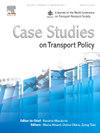A Multi-Objective model for shared-ride automated services: Reducing the price of anarchy through centralized matching
IF 2.4
Q3 TRANSPORTATION
引用次数: 0
Abstract
The rise of Automated Mobility-on-Demand (AMoD) services, such as Waymo and Zoox, has transformed urban mobility. However, the growing demand and expanding robotaxi fleets have the potential to exacerbate congestion. This study introduces a novel centralized ride-matching procedure to enhance the scheduling efficiency of Shared-Ride Automated Mobility-on-Demand Services (SRAMODS). The proposed multi-objective adaptive model addresses the perspectives of on-site, in-vehicle riders, and robotaxi operators by minimizing on-site waiting time, in-vehicle travel duration, and detour distance at each pairing epoch. The proposed model dynamically matches riders within each epoch, with each robotaxi accommodating up to 4 riders simultaneously. A case study using Chicago demand data demonstrates that different weighting distributions lead to distinct matching outcomes, and a balanced weighting across all objectives minimizes the total time spent. Compared to traditional decentralized ride-matching, SRAMODS reduces the price of anarchy—measured as distance traveled per rider—by up to 15%, highlighting the benefits of centralized control. These findings provide policy insights to encourage shared robotaxi adoption through centralized coordination, improving urban mobility while reducing operational inefficiencies and congestion.
共享乘车自动化服务的多目标模型:通过集中匹配降低无政府状态的代价
Waymo和Zoox等按需自动出行(AMoD)服务的兴起改变了城市交通。然而,不断增长的需求和不断扩大的机器人出租车车队有可能加剧拥堵。本研究提出一种新的集中式乘车匹配流程,以提高共享乘车自动按需出行服务(SRAMODS)的调度效率。提出的多目标自适应模型通过最小化现场等待时间、车内行驶时间和每个配对时段的绕行距离,解决了现场、车内乘客和自动驾驶出租车运营商的观点。提出的模型在每个时间段内动态匹配乘客,每辆机器人出租车最多可同时容纳4名乘客。使用芝加哥需求数据的案例研究表明,不同的权重分布导致不同的匹配结果,并且在所有目标之间的平衡权重可以最小化所花费的总时间。与传统的分散式乘车匹配相比,SRAMODS将无政府状态的代价(以每位乘客行驶的距离衡量)降低了15%,突出了集中控制的好处。这些研究结果提供了政策见解,通过集中协调,鼓励共享无人驾驶出租车的采用,改善城市机动性,同时减少运营效率低下和拥堵。
本文章由计算机程序翻译,如有差异,请以英文原文为准。
求助全文
约1分钟内获得全文
求助全文

 求助内容:
求助内容: 应助结果提醒方式:
应助结果提醒方式:


